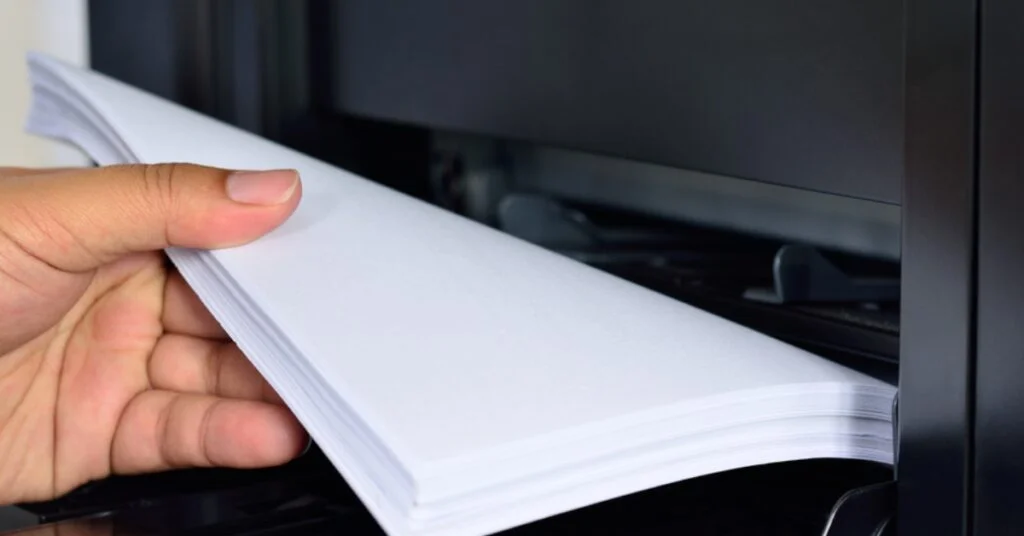
For each printing require there’s a particular sort of paper that will suit the work perfectly. However, with so numerous distinctive sheet sorts and sizes accessible in advertising, it can be troublesome to decide which ones can be used together with your printer and which ones are right for a specific job.
Even when you’ve ought to grips with the run of paper sorts and sizes, there are too diverse coatings and weights to choose from. If you’ve got a particular print work intellect merely requires paper exhortation or you’d rather like to be superior educated for future occupations, examined our conclusive direct-to-printer paper.
In any printed venture, the sort of paper utilized can play a major part, in the event that not the featured one, in how the piece comes over. The measure of the printer paper, its color, weight, coating, brightness, darkness, and other variables ought to come into play when choosing the proper one for a job. Not to say, diverse sorts of printing paper are planned for particular employments, such as inkjet paper, laser paper, cardstock, and photo paper.
In any case, budget-friendly and premium duplicate and multipurpose paper can offer clients a wide run of printing needs – from high-end reports and common presents to quality introductions in an imaginative portfolio. There are so numerous choices of paper accessible that it can now and then be difficult to know where to start looking. This printing direct can offer assistance clarify the conceivable choices so that your following printed piece can take a bow for a work well done.
Key Factors to Consider When Buying Printing Paper:
Paper Thickness & Weight
You have got to think about almost the thickness and weight of paper at the same time. Both degrees how thick, sturdy, and tough the paper could be. A higher-weight, thicker paper will stand up to a beating way better than a lower-weight or more slender paper.
What is Paper Thickness?
Paper thickness is as a rule said when talking approximately cover stock, and it’s basically an estimation of how numerous hundredths of an inch thick a single sheet of paper is. The thickness of a paper is communicated by focuses, where a point is a rise to one-thousandth or .001 inches. Paper that’s 10pt is 0.01 inches thick, 20pt is 0.02 inches thick, etc.
Business cards are awesome illustrations of diverse paper thicknesses. Most commerce cards are printed on 12 or 14-pt cover stock, whereas additional thick cards are printed on 18-pt or 24pt (or thicker) stock. Other items as a rule printed on thick papers incorporate hang labels, entryway holders, bookmarks, bundling, and table tents.
What is Paper Weight?
Paperweight is harder to characterize. Depending on what nation you’re within, the weight of paper can be indicated in an unexpected way. The estimation comes from how much a ream of paper of a specific measure weighs. Paper is weighed in stacks of 500 sheets, and the coming about weight in pounds is the weight assignment for that paper. In case 500 sheets of content weight paper weigh 60 pounds, the paper is called “60# content.”
In case the sheets are cover stock that weighs 120 pounds, the paper is called “120# cover.” In most cases, the more prominent the weight the thicker the paper. May you’ve got a lean paper that’s moreover higher in weight? Beyond any doubt, it would be exceptionally thick. But the Converse, a thick paper that isn’t a better weight, is exceptional.
Here are a few examples:
60# content: duplicate or printer paper, just like the paper utilized for legitimate documents
80# content: heavier paper utilized for flyers, blurbs, or brochures
120# cover: fundamentally lean cardboard, extraordinary for postcards, trade cards, and note cards
Paper Brightness & Opacity
The quality and determinations of your paper can have a sensational impact on the discernment of the pictures and content printed on the paper.
Paper Brightness
Paper brightness is measured employing an extraordinary blue light on a scale of 1 to 100, with 100 being the brightest. The brightness of the paper influences differentiate and impacts how clear the print shows up – the brighter the paper the more discernable it’ll be. Brighter papers moreover show ink colors more precisely, energetically, and absolutely, as the shinning papers are yellower, muddying the colors to some degree.
This makes brighter papers way better suited for the finest quality printing utilized in high-end promoting or fine craftsmanship reproduction. Paper that’s brighter makes the colors pop and fair looks superior. A darker paper can be utilized to form a certain sort of picture that has a darker, more quiet tone but in common, brighter paper works best for colorful plans.
Opacity
Opacity could be a degree of straightforwardness or how much print appears from one side of the paper to the other. Paper that appears nothing from the other side is 100% misty (welcoming cards, postcards). Paper that appears everything is 0% murky (tracing paper). Mistiness is especially critical in the event that you’re printing on both sides of the paper because it can be unattractive, diverting, and difficult to study in case the substance from the other side is obvious.
Coated versus Uncoated
When choosing an ink color, you’ll frequently see the acronyms C and U, which really allude to “coated” and “uncoated” paper stock. The key thing to keep in mind here is that when utilized in reference to spot colors, they’re really talking almost the paper and not the ink. Ink is made up of shade (the color) and the carrier, which is ordinarily oil. The oil portion of the ink splashes into the paper and dries. The color sits upon the best of the mineral or clay coating with coated papers but splashes into the strands with uncoated papers. The sort of paper you’re utilizing can have a lovely critical effect on the way the ink color shows up in genuine life.
Here’s an illustration of how coated versus uncoated paper shows up. You’ll see how the coated paper gives a few additional sparkles.
That “shine” influences how spot colors are shown. For illustration, on the off chance that you compare the “C” and “U” Pantone colors PANTONE 185C and PANTONE 185U side-by-side, one of the primary things you take note of is that PANTONE 185C looks brighter and more soaked than PANTONE 185U. It is actually the precise same ink, but the distinction between the coated and uncoated paper stock changes the way the ink looks when printed.
Paper Material
Paper isn’t fairly made from wood. There are papers made from cloth, manufactured strands, and indeed plastics. These papers serve specialized purposes. On the off chance that you’re stressed almost your effect on the environment, there are forte green papers that are made from more ecologically inviting materials, are sourced from economical woodlands, and biodegrade quicker. In spite of the fact that most of our standard papers are reasonably sourced, other alternatives are accessible.
